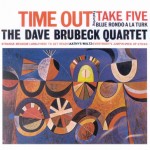This time of year has always been one of transitions, even if it’s just an effort to make a New Year’s resolution. The jazz world saw a transition on December 26, 1967. That was the day the Dave Brubeck Quartet formally disbanded.
Since the quartet had been founded in 1951, there were two mainstays: Brubeck, of course, on piano and alto saxophonist Paul Desmond. For most fans at the time, it was probably nigh on impossible to conceive of a Brubeck ensemble without Desmond.

I’ve previously detailed my jazz education. Undoubtedly one of the LPs I heard during that time — and the one that invariably comes to mind when most people think of the Brubeck Quartet — was Time Out. There’s good reason. Time Out was such a landmark that it was named to the Library of Congress National Recording Registry in 2005.
Recorded in 1959, it explored different, some would say odd, time signatures. The prime example is Brubeck’s “Blue Rondo à la Turk” set in 9/8 meter to echo Turkish rhythms. But that beat underlies less than half the tune. Standard 4/4 time is actually more prevalent as the middle of the tune is comprised of Desmond and then Brubeck strolling through almost quintessential displays of the “West Coast” style of cool jazz. It is a compelling counterpoint to the intensity of the 9/8 approach that opens and closes the tune.
Yet it is “Take Five,” written by Desmond, that is most likely to mark the album for most audiences. Set in 5/4 time, “Take Five” actually reached No. 2 on Billboard’s “Adult Contemporary” charts in 1961 and No. 25 for “Pop Singles.” The LP sold more than a million copies. It took the West Coast style to perhaps its commercial apex.
If bebop was emotional, West Coast cool was cerebral. It was smoother, softer and more laid back. And if anyone epitomized the fluidity of its sound, it was probably Desmond. In fact, he may have described West Coast jazz the best, once likening what he was trying to achieve to the “sound of a dry martini.”
Although even the abstract art on the cover proclaimed this as “modern jazz,” viewed from today’s prisms then-current pictures of Brubeck and Desmond wouldn’t classify them as cool. They generally wore suits when they performed usually, of course, with white shirts and narrow black ties. And then there was the ubiquitous black horn-rimmed glasses that seemed bigger than the ties. Yet the quartet epitomized the cool West Coast school to such an extent that it was highly popular not just in jazz clubs but on college campuses. In fact, it recorded several LPs on campuses and the success of one recorded exclusively on a tour of campuses — Jazz Goes to College — landed Brubeck on the cover of Time magazine in November 1954.
The West Coast sound, though, may well have peaked with Time Out. By the mid-1960s jazz was moving on, with the free jazz movement reflecting the times and the explosion of rock and roll laying the groundwork for fusion. Brubeck decided to devote more time to composition and the quartet disbanded. Desmond, whose sound may be the ultimate expression of West Coast cool, went into semi-retirement. “Take Five” and Time Out, though, remain not only hallmarks of their collaboration, but of an entire genre.
I was unfashionable before anyone knew who I was.
Paul Desmond







